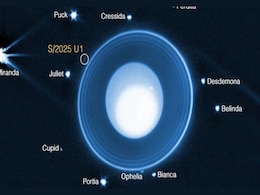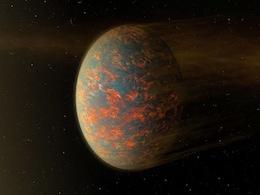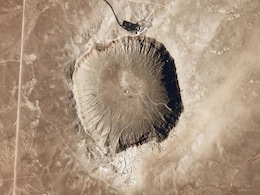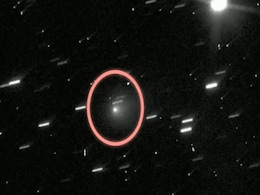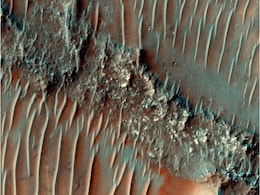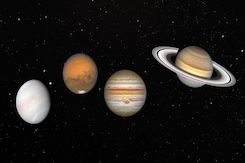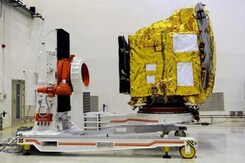Planetary Science
- All
- News
- Videos
-

Researchers Discover New Plasma Wave in Jupiter’s Auroral Skies
- Monday August 25, 2025
- Written by Gadgets 360 Staff
Scientists at the University of Minnesota Twin Cities have detected a new plasma wave in Jupiter’s aurora using NASA’s Juno spacecraft. The finding, published in Physical Review Letters, reveals how Jupiter’s magnetic field shapes auroral activity differently from Earth. The study opens new directions for understanding planetary auroras and m...
-
 www.gadgets360.com
www.gadgets360.com
-

James Webb Telescope Discovers Tiny New Moon Orbiting Uranus
- Saturday August 23, 2025
- Written by Gadgets 360 Staff
A team from the Southwest Research Institute has discovered a tiny new moon orbiting Uranus using NASA’s James Webb Space Telescope. The moon, called S/2025 U1, is just 6 miles (10 kilometers) wide, too small for Voyager 2 to detect during its 1986 flyby. This discovery brings Uranus’s total known moons to 29, with S/2025 U1 orbiting 35,000 mil...
-
 www.gadgets360.com
www.gadgets360.com
-

Mercury Has Shrunk by Several Kilometers Over Billions of Years, Scientists Report
- Tuesday August 19, 2025
- Written by Gadgets 360 Staff
Mercury’s surface reveals it has been shrinking for billions of years due to cooling and faulting. A new study estimates the planet’s radius has contracted by 2.7–5.6 kilometers, offering the most precise figures yet. The findings sharpen understanding of Mercury’s thermal evolution and could help scientists apply the same techniques to tec...
-
 www.gadgets360.com
www.gadgets360.com
-

ESA’s Mars Express Discovers Deep Valleys and Frozen Features Hinting at Mars’ Icy Past
- Thursday August 14, 2025
- Written by Gadgets 360 Staff
In July 2025, the European Space Agency’s Mars Express orbiter captured a high-resolution image of Acheron Fossae, a region marked by deep chasms and ridges on Mars’s surface. These features, created by ancient crustal stretching, split the terrain into raised horsts and sunken grabens. Valley floors reveal smooth surfaces carved by slow-moving...
-
 www.gadgets360.com
www.gadgets360.com
-

NASA Missions Uncover a Diverse Galaxy of Super-Earths, Raising New Questions About Planetary Evolution
- Thursday August 14, 2025
- Written by Gadgets 360 Staff
Super-Earths are among the most common planets in the galaxy, yet none exist in our solar system. Larger than Earth but smaller than Neptune, they range from ocean-covered worlds to scorched, atmosphere-less rocks. Some orbit within habitable zones, making them prime candidates for life. NASA’s Kepler and TESS missions, along with upcoming telesc...
-
 www.gadgets360.com
www.gadgets360.com
-

James Webb Telescope Detects Potential Gas Giant Exoplanet Just 4 Light-Years Away
- Friday August 8, 2025
- Written by Gadgets 360 Staff
Astronomers using JWST have spotted a possible gas giant orbiting Alpha Centauri A, only 4 light-years away. If confirmed, it would be the closest exoplanet to a Sun-like star ever imaged. The discovery could challenge current models of planetary formation in binary systems and open new opportunities for studying nearby worlds.
-
 www.gadgets360.com
www.gadgets360.com
-

Earth’s Oldest Impact Crater Turns Out to Be Much Younger, Scientists Reveal in New Study
- Wednesday August 6, 2025
- Written by Gadgets 360 Staff
The Miralga impact crater in Western Australia, once thought to be Earth’s oldest at 3.5 billion years, has now been redated to after 2.7 billion years ago. With a revised diameter of just 16 kilometers, the structure no longer supports theories of early crust or life formation, but remains scientifically valuable for studying Mars-like planetary...
-
 www.gadgets360.com
www.gadgets360.com
-

Study Reveals What Presence Of CO2 On Eight Saturn Moons Means
- Tuesday July 29, 2025
- Science | Edited by Srishti Singh Sisodia
The study aims to help scientists understand the existence of CO2 on planetary bodies, the process of formation and evolution.
-
 www.ndtv.com
www.ndtv.com
-

Doomed Exoplanet TOI-2109b Spirals Toward Its Star with Three Possible Fates
- Monday July 28, 2025
- Written by Gadgets 360 Staff
The gas giant TOI-2109b, over five times Jupiter’s mass, is spiraling closer to its star in a rare planetary death spiral. With a 16-hour orbit and blistering heat, the exoplanet could either plunge into its host star, be torn apart by tidal forces, or evolve into a rocky super-Earth through photoevaporation. NASA’s TESS and ESA’s Cheops data...
-
 www.gadgets360.com
www.gadgets360.com
-

Hubble Captures First Images of Ancient Interstellar Visitor Comet 3I/ATLAS
- Monday July 28, 2025
- Written by Gadgets 360 Staff
Hubble has captured images of comet 3I/ATLAS, an ancient interstellar object likely 7 billion years old. As only the third known visitor from beyond the solar system, it offers rare insights into distant planetary systems. With its water ice and D-type asteroid-like dust, 3I/ATLAS is now under global scientific scrutiny before it vanishes back into...
-
 www.gadgets360.com
www.gadgets360.com
-

New Study Reveals Mars Faced Heavy Rains: Possible Clue to Ancient Life
- Thursday July 24, 2025
- Written by Gadgets 360 Staff
The revelation that Mars once had Earth-like rainfall reshapes our understanding of planetary evolution. The insights support the theory that early Mars was far more hospitable than previously believed, possibly housing primitive life forms. The findings could guide future missions like NASA’s Perseverance in locating signs of fossilised organism...
-
 www.gadgets360.com
www.gadgets360.com
-

Magnetic Wave Study Detects Lithium in Mercury’s Exosphere for First Time Ever
- Sunday July 20, 2025
- Written by Gadgets 360 Staff
For the first time, scientists have detected lithium in Mercury’s exosphere using magnetic wave signatures found in MESSENGER spacecraft data. The findings link lithium’s release to meteoroid impacts that vaporise planetary material, offering fresh insight into volatile element delivery. This breakthrough reshapes our understanding of Mercury...
-
 www.gadgets360.com
www.gadgets360.com
-

Chandra Spots Distant Baby Planet Losing Its Atmosphere Under Intense X-ray Assault
- Saturday July 19, 2025
- Written by Gadgets 360 Staff
NASA’s Chandra X-ray Observatory has captured a rare glimpse of TOI 1227 b, a young, Jupiter-sized exoplanet losing its atmosphere under intense stellar radiation. Just 8 million years old, the planet is shrinking rapidly as X-rays strip away its mass. Scientists warn it may become a barren rocky core in about a billion years.
-
 www.gadgets360.com
www.gadgets360.com
-

Young Exoplanet Spotted Shedding Atmosphere Under Stellar Radiation
- Thursday July 17, 2025
- Written by Gadgets 360 Staff
NASA’s Chandra X-ray Observatory and Hubble Space Telescope have captured a dramatic cosmic event: a baby exoplanet, TOI 1227 b, is being stripped of its atmosphere by powerful X-rays from its host star. Only 8 million years old and orbiting a red dwarf, this Jupiter-sized planet is losing gas at a rate equal to Earth’s entire atmosphere every ...
-
 www.gadgets360.com
www.gadgets360.com
-

Uranus Found Emitting Internal Heat, Reviving Hopes for Flagship NASA Mission
- Thursday July 17, 2025
- Written by Gadgets 360 Staff
Astronomers have discovered that Uranus emits 12% more heat than it receives from sunlight, contradicting past data from Voyager 2. The internal warmth likely comes from leftover energy in the planet’s core, offering clues to its tilt and interior structure. This unexpected heat has intensified calls for a flagship NASA mission to Uranus. Scienti...
-
 www.gadgets360.com
www.gadgets360.com
-

Researchers Discover New Plasma Wave in Jupiter’s Auroral Skies
- Monday August 25, 2025
- Written by Gadgets 360 Staff
Scientists at the University of Minnesota Twin Cities have detected a new plasma wave in Jupiter’s aurora using NASA’s Juno spacecraft. The finding, published in Physical Review Letters, reveals how Jupiter’s magnetic field shapes auroral activity differently from Earth. The study opens new directions for understanding planetary auroras and m...
-
 www.gadgets360.com
www.gadgets360.com
-

James Webb Telescope Discovers Tiny New Moon Orbiting Uranus
- Saturday August 23, 2025
- Written by Gadgets 360 Staff
A team from the Southwest Research Institute has discovered a tiny new moon orbiting Uranus using NASA’s James Webb Space Telescope. The moon, called S/2025 U1, is just 6 miles (10 kilometers) wide, too small for Voyager 2 to detect during its 1986 flyby. This discovery brings Uranus’s total known moons to 29, with S/2025 U1 orbiting 35,000 mil...
-
 www.gadgets360.com
www.gadgets360.com
-

Mercury Has Shrunk by Several Kilometers Over Billions of Years, Scientists Report
- Tuesday August 19, 2025
- Written by Gadgets 360 Staff
Mercury’s surface reveals it has been shrinking for billions of years due to cooling and faulting. A new study estimates the planet’s radius has contracted by 2.7–5.6 kilometers, offering the most precise figures yet. The findings sharpen understanding of Mercury’s thermal evolution and could help scientists apply the same techniques to tec...
-
 www.gadgets360.com
www.gadgets360.com
-

ESA’s Mars Express Discovers Deep Valleys and Frozen Features Hinting at Mars’ Icy Past
- Thursday August 14, 2025
- Written by Gadgets 360 Staff
In July 2025, the European Space Agency’s Mars Express orbiter captured a high-resolution image of Acheron Fossae, a region marked by deep chasms and ridges on Mars’s surface. These features, created by ancient crustal stretching, split the terrain into raised horsts and sunken grabens. Valley floors reveal smooth surfaces carved by slow-moving...
-
 www.gadgets360.com
www.gadgets360.com
-

NASA Missions Uncover a Diverse Galaxy of Super-Earths, Raising New Questions About Planetary Evolution
- Thursday August 14, 2025
- Written by Gadgets 360 Staff
Super-Earths are among the most common planets in the galaxy, yet none exist in our solar system. Larger than Earth but smaller than Neptune, they range from ocean-covered worlds to scorched, atmosphere-less rocks. Some orbit within habitable zones, making them prime candidates for life. NASA’s Kepler and TESS missions, along with upcoming telesc...
-
 www.gadgets360.com
www.gadgets360.com
-

James Webb Telescope Detects Potential Gas Giant Exoplanet Just 4 Light-Years Away
- Friday August 8, 2025
- Written by Gadgets 360 Staff
Astronomers using JWST have spotted a possible gas giant orbiting Alpha Centauri A, only 4 light-years away. If confirmed, it would be the closest exoplanet to a Sun-like star ever imaged. The discovery could challenge current models of planetary formation in binary systems and open new opportunities for studying nearby worlds.
-
 www.gadgets360.com
www.gadgets360.com
-

Earth’s Oldest Impact Crater Turns Out to Be Much Younger, Scientists Reveal in New Study
- Wednesday August 6, 2025
- Written by Gadgets 360 Staff
The Miralga impact crater in Western Australia, once thought to be Earth’s oldest at 3.5 billion years, has now been redated to after 2.7 billion years ago. With a revised diameter of just 16 kilometers, the structure no longer supports theories of early crust or life formation, but remains scientifically valuable for studying Mars-like planetary...
-
 www.gadgets360.com
www.gadgets360.com
-

Study Reveals What Presence Of CO2 On Eight Saturn Moons Means
- Tuesday July 29, 2025
- Science | Edited by Srishti Singh Sisodia
The study aims to help scientists understand the existence of CO2 on planetary bodies, the process of formation and evolution.
-
 www.ndtv.com
www.ndtv.com
-

Doomed Exoplanet TOI-2109b Spirals Toward Its Star with Three Possible Fates
- Monday July 28, 2025
- Written by Gadgets 360 Staff
The gas giant TOI-2109b, over five times Jupiter’s mass, is spiraling closer to its star in a rare planetary death spiral. With a 16-hour orbit and blistering heat, the exoplanet could either plunge into its host star, be torn apart by tidal forces, or evolve into a rocky super-Earth through photoevaporation. NASA’s TESS and ESA’s Cheops data...
-
 www.gadgets360.com
www.gadgets360.com
-

Hubble Captures First Images of Ancient Interstellar Visitor Comet 3I/ATLAS
- Monday July 28, 2025
- Written by Gadgets 360 Staff
Hubble has captured images of comet 3I/ATLAS, an ancient interstellar object likely 7 billion years old. As only the third known visitor from beyond the solar system, it offers rare insights into distant planetary systems. With its water ice and D-type asteroid-like dust, 3I/ATLAS is now under global scientific scrutiny before it vanishes back into...
-
 www.gadgets360.com
www.gadgets360.com
-

New Study Reveals Mars Faced Heavy Rains: Possible Clue to Ancient Life
- Thursday July 24, 2025
- Written by Gadgets 360 Staff
The revelation that Mars once had Earth-like rainfall reshapes our understanding of planetary evolution. The insights support the theory that early Mars was far more hospitable than previously believed, possibly housing primitive life forms. The findings could guide future missions like NASA’s Perseverance in locating signs of fossilised organism...
-
 www.gadgets360.com
www.gadgets360.com
-

Magnetic Wave Study Detects Lithium in Mercury’s Exosphere for First Time Ever
- Sunday July 20, 2025
- Written by Gadgets 360 Staff
For the first time, scientists have detected lithium in Mercury’s exosphere using magnetic wave signatures found in MESSENGER spacecraft data. The findings link lithium’s release to meteoroid impacts that vaporise planetary material, offering fresh insight into volatile element delivery. This breakthrough reshapes our understanding of Mercury...
-
 www.gadgets360.com
www.gadgets360.com
-

Chandra Spots Distant Baby Planet Losing Its Atmosphere Under Intense X-ray Assault
- Saturday July 19, 2025
- Written by Gadgets 360 Staff
NASA’s Chandra X-ray Observatory has captured a rare glimpse of TOI 1227 b, a young, Jupiter-sized exoplanet losing its atmosphere under intense stellar radiation. Just 8 million years old, the planet is shrinking rapidly as X-rays strip away its mass. Scientists warn it may become a barren rocky core in about a billion years.
-
 www.gadgets360.com
www.gadgets360.com
-

Young Exoplanet Spotted Shedding Atmosphere Under Stellar Radiation
- Thursday July 17, 2025
- Written by Gadgets 360 Staff
NASA’s Chandra X-ray Observatory and Hubble Space Telescope have captured a dramatic cosmic event: a baby exoplanet, TOI 1227 b, is being stripped of its atmosphere by powerful X-rays from its host star. Only 8 million years old and orbiting a red dwarf, this Jupiter-sized planet is losing gas at a rate equal to Earth’s entire atmosphere every ...
-
 www.gadgets360.com
www.gadgets360.com
-

Uranus Found Emitting Internal Heat, Reviving Hopes for Flagship NASA Mission
- Thursday July 17, 2025
- Written by Gadgets 360 Staff
Astronomers have discovered that Uranus emits 12% more heat than it receives from sunlight, contradicting past data from Voyager 2. The internal warmth likely comes from leftover energy in the planet’s core, offering clues to its tilt and interior structure. This unexpected heat has intensified calls for a flagship NASA mission to Uranus. Scienti...
-
 www.gadgets360.com
www.gadgets360.com


